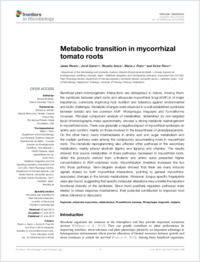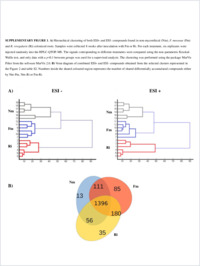Metabolic transition in mycorrhizal tomato roots
- Rivero, Javier Department of Soil Microbiology and Symbiotic Systems, Estación Experimental del Zaidín – Consejo Superior de Investigaciones Científicas, Granada, Spain
- Gamir, Jordi Metabolic Integration and Cell Signaling Laboratory, Associated Unit UJI-CSIC, Plant Physiology Section, Department of Ciencias Agrarias y del Medio Natural, Universitat Jaume I, Castellón, Spain - Unit of Plant Biology, Department of Biology, University of Fribourg, Switzerland
- Aroca, Ricardo Department of Soil Microbiology and Symbiotic Systems, Estación Experimental del Zaidín – Consejo Superior de Investigaciones Científicas, Granada, Spain
- Pozo, María J. Department of Soil Microbiology and Symbiotic Systems, Estación Experimental del Zaidín – Consejo Superior de Investigaciones Científicas, Granada, Spain
- Flors, Víctor Metabolic Integration and Cell Signaling Laboratory, Associated Unit UJI-CSIC, Plant Physiology Section, Department of Ciencias Agrarias y del Medio Natural, Universitat Jaume I, Castellón, Spain
-
23.06.2015
Published in:
- Plant Biotic Interactions. - 2015, p. 598
English
Beneficial plant–microorganism interactions are widespread in nature. Among them, the symbiosis between plant roots and arbuscular mycorrhizal fungi (AMF) is of major importance, commonly improving host nutrition and tolerance against environmental and biotic challenges. Metabolic changes were observed in a well-established symbiosis between tomato and two common AMF: Rhizophagus irregularis and Funneliformis mosseae. Principal component analysis of metabolites, determined by non-targeted liquid chromatography–mass spectrometry, showed a strong metabolic rearrangement in mycorrhizal roots. There was generally a negative impact of mycorrhizal symbiosis on amino acid content, mainly on those involved in the biosynthesis of phenylpropanoids. On the other hand, many intermediaries in amino acid and sugar metabolism and the oxylipin pathway were among the compounds accumulating more in mycorrhizal roots. The metabolic reprogramming also affected other pathways in the secondary metabolism, mainly phenyl alcohols (lignins and lignans) and vitamins. The results showed that source metabolites of these pathways decreased in mycorrhizal roots, whilst the products derived from α-linolenic and amino acids presented higher concentrations in AMF-colonized roots. Mycorrhization therefore increased the flux into those pathways. Venn-diagram analysis showed that there are many induced signals shared by both mycorrhizal interactions, pointing to general mycorrhiza-associated changes in the tomato metabolome. Moreover, fungus-specific fingerprints were also found, suggesting that specific molecular alterations may underlie the reported functional diversity of the symbiosis. Since most positively regulated pathways were related to stress response mechanisms, their potential contribution to improved host stress tolerance is discussed.
- Faculty
- Faculté des sciences et de médecine
- Department
- Département de Biologie
- Language
-
- English
- Classification
- Biological sciences
- License
-
License undefined
- Identifiers
-
- RERO DOC 257049
- DOI 10.3389/fmicb.2015.00598
- Persistent URL
- https://folia.unifr.ch/unifr/documents/304557
Other files
Statistics
Document views: 130
File downloads:
- pdf: 195
- Supplementary material: 145

